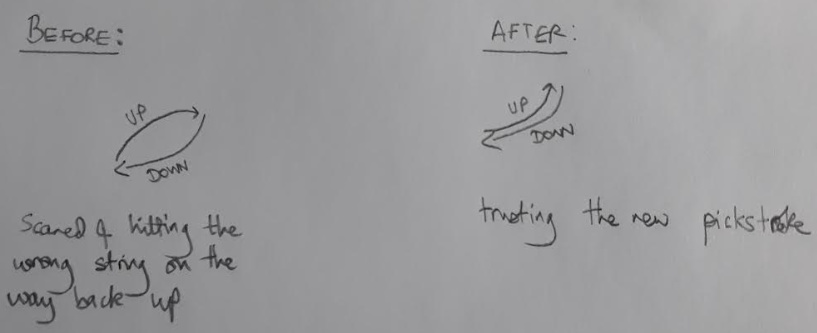Hi there
I am new to this community - I have been working on my crosspicking/general speed for about a year, and decided to try here for some advice and have recorded myself for the first time.
Anyway - here is a clip of me playing a passage at 16th notes at 105bpm (fast and slowed down), I have just realised I am ahead of the click, but anyway…
Normal Speed:
Slowed Down:
Basically I can’t get much faster than this after bashing away for this tune for 3 months. I have been practicing my curved motion crosspicking technique. I can really nail this tune at 16th notes at 85/bpm, but this seems to be my “wall” for it feeling clean, comfortable and smooth - you can tell from the clip that I am really struggling at 105bpm, and there are youtubers who can nail this at 140/150bpm 
Anyway my questions are:
-
Is my grip on the pick ok? at this tempo I feel like I am really fighting the strings. I am using a jazz III XL ultex pick (1.38mm)
-
Is my pick depth too much? Do I need even less pick hitting the strings?
-
Are my curved motions ok on the up and the down? does it need to be more curved? less curved?
-
Are my motions too large? Do they need to be smaller for those faster speeds? (120bpm +)?
-
When I play the ascending and descending licks from the 4th string to the 1st string and back again - I feel like my hand should track down the strings, yet my hand stays planted - do I need to work on this?
-
Just how do I practice this kind of stuff and build a whole song up to speed? At this point in my playing, I can play small passages fast - for example Troy’s Malmsteen 6-note descending pattern across 3 strings at (16th note triplets) at 105bpm - which is not slow, but for crosspicking, I just can’t get past baby speeds
 . So how can I work this up, I get the feeling that slow metronome practice with crosspicking bluegrass songs (which is what I want to learn) never gets me past being able to play a song at more than 16th notes at 90bpm tops…
. So how can I work this up, I get the feeling that slow metronome practice with crosspicking bluegrass songs (which is what I want to learn) never gets me past being able to play a song at more than 16th notes at 90bpm tops…
Many thanks - I hope this was the right kind of post to do for this kind of feedback, please be gentle, I am still learning and very discouraged by the seemingly gargantuan task of playign guitar fast and well…
Cheers
Rohit



